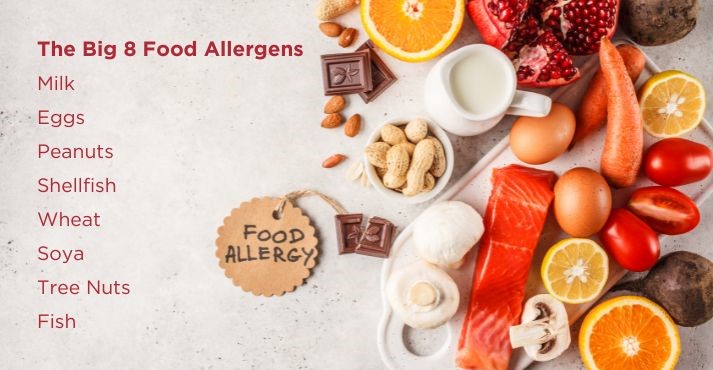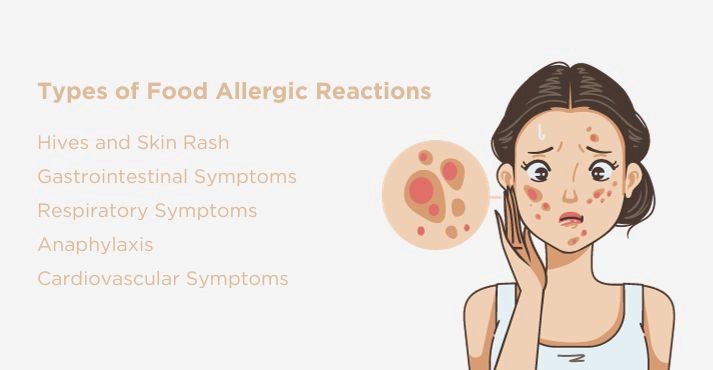Food allergies are prevalent.
Every year, millions of people are adversely affected by the food consumed. Vomiting, diarrhea, abdominal pain, and fever are some of the most common types of food allergies.
Over the last decade, the interest in food allergens has improved dramatically due to growing health problems worldwide.
So, why is it important to know about food allergies as a food and beverage manufacturer?
Some people may not even know they have an allergy, as the symptoms may be minor, but you must ensure labels on the product clearly state all the ingredients.
Accurate labeling and allergen management prevent adverse reactions, build trust, and comply with regulations. Prioritizing allergy awareness safeguards public health and maintains the integrity of the food industry.
This blog post will explore everything you need to know about food allergens.
- Understanding the Big 8 Food Allergens
- Prevalence of Food Allergies
- Types of Food-Allergic Reactions
- Global Regulations on Labeling and Allergen Disclosure
- Best Allergen Management Practices in Food Service
Understanding the Big 8 Food Allergens

Food allergy is an immune system reaction that happens soon after eating a particular food. Most reactions cause mild symptoms, but some are severe and may even be life-threatening.
There are two categories of food allergies, including immunoglobulin E (IgE) mediated and non-IgE mediated.
IgE-mediated food allergies involve the immune system producing IgE antibodies in response to specific food proteins, leading to rapid and often severe allergic reactions.
Non-IgE-mediated food allergies involve the immune system’s different components, such as T cells or immune complexes, causing delayed and typically milder allergic reactions.
Understanding food allergies enables individuals to make informed dietary choices, manage risks, and adequately care for those affected.
Common allergens include proteins like casein in milk, ovalbumin in eggs, gliadin in wheat, and specific proteins in peanuts, shellfish, soy, tree nuts, and fish.
When an allergic person ingests or comes into contact with these proteins, their immune system reacts, leading to a range of symptoms from mild, such as itching and hives, to severe, such as anaphylaxis.
Let’s discuss some of the most common food allergens:
1. Milk
Allergic reactions to milk result from proteins like casein and whey. When ingested, cow milk proteins can trigger symptoms ranging from mild, such as hives and digestive issues, to severe, including anaphylaxis, especially in individuals with a milk allergy.
A cow’s milk allergy diagnosis means all milk products must be avoided. Children or adults with cow’s milk show a reaction within 5–30 minutes of ingesting. This includes any foods or drinks that contain:
- Milk
- Milk powder
- Cheese
- Butter
- Margarine
- Yogurt
- Cream
- Ice cream
Moreover, cross-contamination is a concern; some individuals may tolerate heat-processed milk products.
2. Eggs
Egg allergies involve a reaction to proteins like ovalbumin.
When individuals with egg allergies consume eggs, the immune system identifies these proteins as harmful, leading to various symptoms such as skin reactions, gastrointestinal issues, respiratory distress, and, in severe cases, anaphylaxis.
Cooking eggs may reduce allergenicity, but caution is still necessary.
3. Peanuts
Peanuts are a common allergen due to specific proteins like Ara h 1 and Ara h 2. Reactions can elicit severe allergic reactions, ranging from skin symptoms to life-threatening anaphylaxis.
Cross-contamination risks and the prevalence of peanuts in various foods contribute to their widespread allergenicity.
4. Shellfish
Shellfish allergies often involve crustaceans like shrimp, crab, and lobster. Allergic reactions can be severe, including swelling, difficulty breathing, and digestive issues.
Cross-contamination risks and vigilant avoidance are critical considerations for individuals with shellfish allergies.
Examples of shellfish include:
- Shrimp
- Prawns
- Crayfish
- Lobster
- Squid
- Scallops
A shellfish allergy doesn’t tend to resolve over time, so individuals need to avoid it from their diet.
5. Wheat
Wheat allergies are often linked to gluten-related proteins, such as gliadin. When individuals with wheat allergies consume gluten-containing products, the immune system reacts, causing allergic responses.
Individuals with celiac disease or non-celiac gluten sensitivity must avoid wheat and other grains containing the protein gluten.
Symptoms can affect the skin, respiratory system, or gastrointestinal tract, varying in severity. Individuals with wheat allergies may need to avoid not just bread but various wheat-containing products.
6. Soy
Soy allergies result from proteins like Glym 4. Symptoms range from mild to severe, affecting the skin, respiratory system, or digestive tract.
Cross-reactivity with other legumes can occur, requiring careful management. Since soy is found in many foods, such as soya milk and soya sauce, it’s important to read food labels.
7. Tree Nuts
Tree nuts, including almonds, walnuts, and cashews, can trigger allergic reactions due to specific proteins present. Proteins like Pru du 1 in almonds and Jug r 1 in walnuts may provoke immune responses.
Some examples of tree nuts include:
- Brazil nuts
- Almonds
- Cashews
- Macadamia nuts
- Pistachios
- Pine nuts
- Walnuts
Allergic symptoms range from mild, such as itching and hives, to severe, including anaphylaxis. Cross-reactivity between different tree nuts is possible, necessitating careful management and avoidance.
8. Fish
Fish allergies involve proteins like parvalbumin. Reactions can be severe, with symptoms ranging from hives to anaphylaxis. Cross–contamination risks are high, necessitating strict avoidance and scrutiny of food labels.
Prevalence of Food Allergies

Reactions to food, including allergies, have been known for centuries. Food allergies exhibit varying prevalence across demographics, with children experiencing higher rates. Food allergy news reveals that the prevalence of food allergies may be increasing worldwide.
The worldwide prevalence of food allergy is around 4% of children and 1% of adults, with an increased prevalence in the past two decades.
Moreover, an electronic household survey in the USA estimated that 8% of children have a food allergy, with 2.4% having multiple food allergies and 3% having experienced severe reactions.
A new Northwestern Medicine study, the first population-based food allergy in the U.S., showcases racial and ethnic differences in all age groups. 11% of adults and 8% of children in the U.S.— touch adults and children of every race and ethnicity.
Moreover, the prevalence of food allergy was lowest within households earning more than $150,000 per year (8.3%).
The rising prevalence of food allergies has driven increased demand for organic foods and plant-based dairy alternatives.
People with allergies seek safer, allergen-free options, increasing the growth of organic produce. Plant-based dairy alternatives, free from common allergens like cow’s milk, cater to those with dietary restrictions, contributing to the expanding market for allergen-friendly products.
Types of Food-Allergic Reactions

Food allergic reactions usually develop within a few minutes to two hours after eating the offending food. It is essential to take all symptoms of food allergy seriously.
Common food-allergic reactions include
Hives and Skin Rash: One of the most common signs of food allergy is having hives and skin rashes as a reaction to food. They manifest as red, itchy welts on the skin, signaling an immune response to allergens.
Gastrointestinal Symptoms: Mild to severe gastrointestinal symptoms include nausea, abdominal pain, and diarrhea. In severe cases, it can lead to life-threatening conditions like anaphylaxis.
Respiratory Symptoms: Respiratory symptoms range from mild, such as nasal congestion, to severe, including wheezing and difficulty breathing, indicating potential allergen exposure.
Anaphylaxis: Anaphylaxis is a severe, rapid-onset allergic reaction affecting multiple systems. Symptoms may include swelling, difficulty breathing, and a drop in blood pressure, requiring immediate medical attention.
Cardiovascular Symptoms: In rare cases, food allergies can trigger cardiovascular symptoms, causing heart palpitations or a rapid pulse. Severe reactions may lead to shock, emphasizing the need for prompt intervention and emergency care.
Global Regulations on Labeling and Allergen Disclosure

Global regulations ensure consistent, clear, and transparent information for consumers. The framework is essential for preventing accidental allergen exposure, mitigating health risks, and promoting informed food choices.
It helps individuals identify and avoid allergens, supports public health, and establishes accountability for food manufacturers, developing a commitment to allergen safety in the food industry.
Food Allergen Labeling and Consumer Protection Act (FALCPA)
The Food Allergen Labeling and Consumer Protection Act (FALCPA) is a United States law that requires all food labels in the United States to list ingredients that may cause allergic reactions.
Manufacturers must list common allergens like peanuts, tree nuts, milk, eggs, and more, ensuring consumers can quickly identify potential allergens in food products.
Health Canada’s Food Allergen Labeling Regulations
Health Canada’s Food Allergen Labeling Regulations require that most prepackaged foods carry a label and that the ingredients appear on labels in decreasing order of proportion.
Ingredients and components derived from allergens must be identified. Precautionary allergen labeling is recommended when cross-contamination risks exist.
Due to the complexity of the changes and the foods’ shelf-life, Health Canada provided manufacturers 18 months to implement the new allergen labeling regulations.
Australian Food Standards Code – Standard 1.2.3
Australian Food Standards Code – Standard 1.2.3 requires mandatory advisory statements for certain foods or when certain substances are present in foods.
Clear identification of allergens is required on packaged foods. Manufacturers must adhere to specific formatting and terminology for allergen labeling to enhance consumer understanding.
European Union Regulation (EU) No 1169/2011 on Food Information to Consumers
European Union Regulation (EU) No 1169/2011 on Food Information to Consumers provides the basis for the assurance of a high level of consumer protection about food information, taking into account the differences in the perception of consumers and their information needs.
Regulation must be followed for labeling pre-packaged and non-pre-packaged foods. Allergens must be highlighted in the ingredients list, and specific terms are used for clarity. The regulation aims to provide transparent information to consumers, promoting safe food choices.
Best Allergen Management Practices in Food Service
Food allergy information is essential in managing allergens to ensure customer safety. The Food and beverage industry must implement allergen management practices, including staff training, transparent menu labeling, and effective customer communication.
Accurate allergen information, cross-contamination prevention, and accommodating special dietary needs are essential. You can avail the benefits of attending an F&B exhibition by being more aware of the ingredients and components of your food.
Consider the following best allergen management practices:
Clear Menu Labelling
Labeling allergens on menus informs customers of potential risks, enabling them to make safe choices. This practice enhances transparency and empowers individuals with food allergies to navigate menus confidently.
Training Staff
Comprehensive staff training on allergen awareness and handling is crucial. Employees should understand the severity of allergies, proper communication, and preventive measures to ensure a safe dining environment.
Proper training in the food and beverage sector and the hospitality industry is hugely important, as there are numerous matters of health and safety to be aware of.
Separation of Allergen-Free Preparations
Maintaining dedicated preparation areas and utensils for allergen-free dishes minimizes the risk of cross-contamination, providing a safer option for customers with food allergies. Also, you can opt for a flexitarian diet and use ingredients accordingly.
Allergen-Free Alternatives
Offering allergen-free alternatives ensures diverse menu options for customers with dietary restrictions, promoting inclusivity and accommodating various food preferences and allergies.
Transparent Ingredient Sourcing
Communicating ingredient sources helps customers identify potential allergens. Transparent sourcing enables informed choices, developing trust in the F&B brand’s commitment to allergen safety and ingredient quality.
Emergency Response Training
Staff should be trained in emergency response protocols, ensuring a swift and appropriate reaction if a customer experiences an allergic reaction. Quick and informed responses can be life-saving in critical situations.
Conclusion
Allergic reactions can be life-threatening, and everyone should know how to identify the symptoms of a food allergy emergency.
Now that you know why it is essential to know about food allergies, you must ensure that your Food and beverage products have labels to enable people to make informed dietary choices to reduce the risks of allergic reactions.
As for those with allergies, the food establishments, through proper allergen management, contribute to a safer dining environment, build customer trust, and demonstrate social responsibility.
However, a collective understanding of food allergens is indispensable for creating a more inclusive and health-conscious society. Also, participating in or attending an International food show will help you stay ahead of the food and beverage industry competition.












